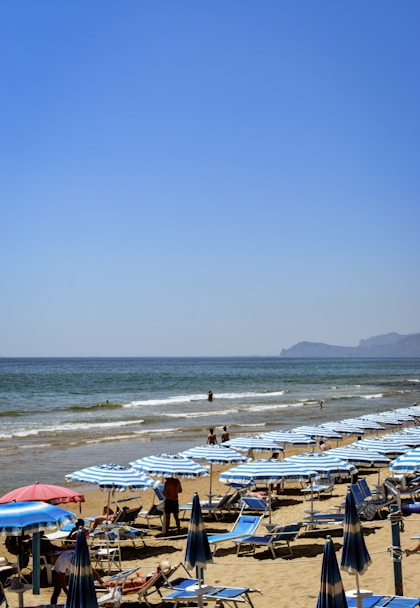Sperlonga: A Town With Splendid Views of the Deep Blue Sea
An exploration of one of Italy's most spectacular seaside towns.
ARTICLES


International tourism is discovering another fascinating part of Italy, so far unknown to some many travellers. Sperlonga, the town in the Lazio region where the memory of Ulysses is still in evidence, with white houses perched on a peak with the blue sea breaking in long waves at its foot. Until a few years ago it was still a mule track with a few paved stretches bearing witness to the ancient Roman road to Gaeta.
If you visit this part of the coast during the Easter period, the whole town looks like a stage, flanked by gleaming stairways leading steeply down to the sea. Swallows crisscross in the sky high above, adding their calls to the notes played by a local band. Unfortunately, those splendid large, irregular stones of a pale grey, that looked as though they have been polished with wax, no longer cover the way through the city centre.
In recent times, the town has been invaded by asphalting machines to make it easier for women to walk in high heels. As time constantly changes, the fashion for new stones did not spare the fountain installed here as in so many other Italian towns, when drinkable water arrived with the Royal crest of the house of Savoy. It is sad that it was demolished together with the stone benches to make way for a massive fountain with multiple jets, again in railway station style.
The ancient church with the lofty name of Santa Mariae Splelonchae, and a flight of steps leading up to its tall doorway, is now in ruins. Its rear entrance, surmounted by a clock from the Bourbon era, is barred. Alongside this door is a Latin inscription cut at an angle into the stone frame for lack of space: this is one of the most singular features of the architecture of a town built like a closed fist to defend itself against pirates. The new two-colour church, a cross between a Chinese pagoda and a circus tent, is instead a perfect example of the architectural eyesores of the appalling 1960s.
Despite human intervention and events, however, Sperlonga is still perhaps a unique place in the Mediterranean panorama, not for its golden beach, where the sea dissolves into light, limpid waves or rages furiously full of dangers, but for the Villa of Teberius, which lay buried for centuries but which was brought to light when the work on the new Via Flacca began in 1956. More than a villa, it was a small town stretching from the foot of the peak where the present town stands down to the large grotto at the end of the inlet and on into the area now covered by the sea. Floating on the surface of the water, you can still see the remains of the ancient walls rising from the sandy seabed. Thanks to the World Wildlife Funds, which has succeeded in making the area a tiny protected oasis, countless fish now dart among the ancient stones encrusted with seaweed and molluscs. You can also let yourself be carried along by the waves to gaze upon the grotto where the Roman emperors used freshwater springs to create a spectacular swimming pool supplied with hot and cold water and embellished with splendid Hellenistic statues from the 2nd century BC. Though amputated and decapitated by the monks who inhabited the grotto in mediaeval times, these sculptures can now be seen in the archaeological museum, overlooking the sea and surrounded by olive trees. Unfortunately, only a very small part of this Villa-Town, where Tiberius lived from 14AD on, has been excavated. The rest is still buried beneath the earth and the dunes, which are under constant attack from bulldozers to build mega parking lots for the summer bathers.
The town itself is better protected. It was probably built by people fleeing from the Puglia region who saw the cliff top as a place of refuge from attack by seafaring predators. The houses built up against one another, the narrow streets (where no more than two people can walk abreast), and the steep steps wedged beneath the arches that can be barred at the first sign of danger have proved a stronger defence against the assault of modern predators.
In the days of the Saracens, Sperlonga was defended to the rear by mountains covered with Mediterranean vegetation and by forests and swamps in the flatland to the north. The ancient attackers have now disappeared, but so have the forests and swamps together with most of the cluster pines and the clumps of myrtle and lentis. Chainsaws and fire have succeeded where the Turks and pirates failed. In the gloomy months of the dark winter, the sinister whine of steel teeth spares nothing, not even age-old carob trees, in order to create parking space for visitors. In addition to concrete space, workers swiftly erect shacks that soon turn into houses and then villas with a view, cheerfully indifferent to the buried town with its mosaics and splendid history.
However, when the summer visitors and bathers who invade this magnificent town disappear, together with the red hot cars lined up alongside the dunes, the expanse of pale golden sand stretching down to the huge cavern of the grotto of Tiberius, and the ripping green water of its pools once again becomes a place of magic and rare beauty. The illusion is reborn that someday the cluster of white houses perched high above may once again become the faithful guardian of the fabulous home of an emperor who, though despotic and sometimes ruthless, was passionately enamoured of the beauty.
